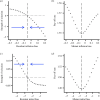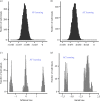The evolutionary consequences of learning under competition
- PMID: 39110908
- PMCID: PMC11305653
- DOI: 10.1098/rspb.2024.1141
The evolutionary consequences of learning under competition
Abstract
Learning is a taxonomically widespread process by which animals change their behavioural responses to stimuli as a result of experience. In this way, it plays a crucial role in the development of individual behaviour and underpins substantial phenotypic variation within populations. Nevertheless, the impact of learning in social contexts on evolutionary change is not well understood. Here, we develop game theoretical models of competition for resources in small groups (e.g. producer-scrounger and hawk-dove games) in which actions are controlled by reinforcement learning and show that biases in the subjective valuation of different actions readily evolve. Moreover, in many cases, the convergence stable levels of bias exist at fitness minima and therefore lead to disruptive selection on learning rules and, potentially, to the evolution of genetic polymorphisms. Thus, we show how reinforcement learning in social contexts can be a driver of evolutionary diversification. In addition, we consider the evolution of ability in our games, showing that learning can also drive disruptive selection on the ability to perform a task.
Keywords: disruptive selection; fitness minima; hawk–dove game; negative frequency dependence; producer–scrounger game; reinforcement learning.
Conflict of interest statement
We declare we have no competing interests.
Figures





Similar articles
-
Behavioural specialization and learning in social networks.Proc Biol Sci. 2022 Aug 10;289(1980):20220954. doi: 10.1098/rspb.2022.0954. Epub 2022 Aug 10. Proc Biol Sci. 2022. PMID: 35946152 Free PMC article.
-
Beyond replicator dynamics: From frequency to density dependent models of evolutionary games.J Theor Biol. 2018 Oct 14;455:232-248. doi: 10.1016/j.jtbi.2018.07.003. Epub 2018 Jul 7. J Theor Biol. 2018. PMID: 29990466
-
Bimatrix games that include interaction times alter the evolutionary outcome: The Owner-Intruder game.J Theor Biol. 2019 Jan 7;460:262-273. doi: 10.1016/j.jtbi.2018.10.033. Epub 2018 Oct 15. J Theor Biol. 2019. PMID: 30336159
-
On the origin of allostasis and stress-induced pathology in farm animals: celebrating Darwin's legacy.Vet J. 2009 Dec;182(3):378-83. doi: 10.1016/j.tvjl.2009.08.023. Epub 2009 Sep 10. Vet J. 2009. PMID: 19747860 Review.
-
Female competition and its evolutionary consequences in mammals.Biol Rev Camb Philos Soc. 2011 May;86(2):341-66. doi: 10.1111/j.1469-185X.2010.00149.x. Biol Rev Camb Philos Soc. 2011. PMID: 20636474 Review.
References
-
- Shettleworth SJ. 2009. Cognition, evolution, and behavior. In Cognition, evolution, and behavior. Oxford, UK: Oxford University Press. (10.1093/oso/9780195319842.001.0001) - DOI
-
- Dunlap AS, Austin MW, Figueiredo A. 2019. Components of change and the evolution of learning in theory and experiment. Anim. Behav. 147 , 157–166. (10.1016/j.anbehav.2018.05.024) - DOI
-
- Stephens DW. 1991. Change, regularity, and value in the evolution of animal learning. Behav. Ecol. 2 , 77–89. (10.1093/beheco/2.1.77) - DOI
MeSH terms
Grants and funding
LinkOut - more resources
Full Text Sources

